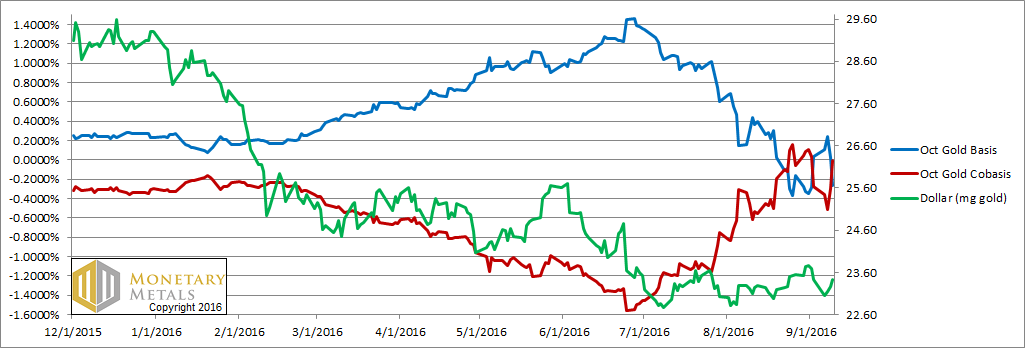The prices of both metals were down last holiday-shortened (Labor Day in the US) week, especially on Friday. The decline corresponded to a spike in interest rates.
Of course everyone watched the action of the stock market on Friday. Whatever the proximate cause, the root is credit. When borrowing to buy assets does not work, then selling assets to repay debt is required.
It could be companies who bought their own shares, it could be European banks. It could be leveraged investors speculators in their Etrade accounts.
This leads us to another reason why a high basis is a bearish signal for the USD price of a metal. The basis is the carrying cost. One month ago, if you bought a December silver contract, you paid a big premium. As we recall, it was around 14 cents per ounce. As you hold that contract, this premium decays.
If you wait until First Notice Day, it could be completely gone or even negative. That is, you may get a few pennies under the spot price to sell the contract. If you roll the contract—i.e. sell December and buy March—you will incur that cost of carry again.
Think of this like buying a house, not to live in, but just to await a higher price. Every month, you have to pay taxes, insurance, and a guy to mow the lawn. The more that adds up, the more urgency you will feel to sell the house (we won’t address renting it to cover the costs, as there is no way to rent a futures contract).
The higher the basis, the bigger this steady erosion of the investor’s speculator’s capital credit. It’s a nagging incentive to close the position that, at some point, must and will be heeded. Of course, once the selling begins then the price falls, adding to the losses.
Last week, we said:
“The price of silver went up about 3%. Of course these labor announcements have no long-term impact on the price of anything, which is driven by supply and demand fundamentals.”
This week, the price did not quite fall back to the level prior to last weeks’ labor report fueled spike, but it came close.
Read on for the only true picture of the fundamentals of the monetary metals. But first, here’s the graph of the metals’ prices.
The Prices of Gold and Silver

Next, this is a graph of the gold price measured in silver, otherwise known as the gold to silver ratio. It rose 1.5 points this week.
The Ratio of the Gold Price to the Silver Price

For each metal, we will look at a graph of the basis and cobasis overlaid with the price of the dollar in terms of the respective metal. It will make it easier to provide brief commentary. The dollar will be represented in green, the basis in blue and cobasis in red.
Here is the gold graph.
The Gold Basis and Cobasis and the Dollar Price

The price of gold started moving up this week, but then fell back to unchanged (OK, up a buck) from last week.
The October basis (i.e. abundance) was down, and cobasis up. However, that was not true for farther-out contracts (next week, we will switch to the December gold contract).
The Monetary Metals fundamental price of gold is down a few bucks from last week, just under the market price now.
Let’s look at silver.
The Silver Basis and Cobasis and the Dollar Price

In silver, we had a dramatic price move downward. We would expect that to be driven by the selling of futures. If so, that would have a falling basis and rising cobasis. And sure enough, that is what happened.
The fundamental price is up about 50 cents, but still in the mid 17’s.
We once recall a silver permabull call silver the “good news metal”. Well, if that be true then it’s possible that it is also the “bad news metal” whose price will fall along with stocks in a declining economic and credit environment, growing inventories and more importantly inventory-to-sales ratios, disappointing sell-through, etc.
